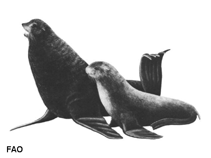Callorhinus ursinus (Linnaeus, 1758)
Northern fur seal| Native range | All suitable habitat | Point map | Year 2050 |

|
| This map was computer-generated and has not yet been reviewed. |
| Callorhinus ursinus AquaMaps Data sources: GBIF OBIS |
Classification / Names Common names | Synonyms | CoL | ITIS | WoRMS
Mammalia | Carnivora | Otariidae
Environment: milieu / climate zone / depth range / distribution range Ecology
Bathydemersal. Subtropical; 90°N - 0°S, 180°W - 180°E
Distribution Countries | FAO areas | Ecosystems | Occurrences | Introductions
Pacific Ocean and the Arctic.
Length at first maturity / Size / Weight / Age
Maturity: Lm ? range ? - ? cm Max length : 210 cm TL male/unsexed; (Ref. 1394); 150 cm TL (female); max. published weight: 270.0 kg (Ref. 1394); max. published weight: 270.0 kg
Feeds on many varieties of epipelagic and vertically migrating schooling and non-schooling fish and squid; feeding is at night (Ref. 1394). Feeds on many varieties of epipelagic and vertically migrating schooling and non-schooling fish and squid; feeding is at night (Ref. 1394).
Life cycle and mating behavior Maturity | Reproduction | Spawning | Eggs | Fecundity | Larvae
Estrus and copulation occur about a week after parturition. Implantation is expected 120 days after copulation.
Main reference
References | Coordinator | Collaborators
Jefferson, T.A., S. Leatherwood and M.A. Webber. 1993. (Ref. 1394)
IUCN Red List Status (Ref. 130435)
Vulnerable (VU) (A2b); Date assessed: 26 March 2015
CITES status (Ref. 108899)
Not Evaluated
CMS (Ref. 116361)
Not Evaluated
Threat to humans
Human uses
Fisheries: commercial
FAO - Fisheries: landings, species profile | FishSource | Sea Around Us
Tools
More information
Internet sources
BHL | BOLD Systems | CISTI | DiscoverLife | FAO(Fisheries: species profile; publication : search) | Fishipedia | GenBank (genome, nucleotide) | GloBI | Gomexsi | Google Books | Google Scholar | Google | PubMed | Tree of Life | Wikipedia (Go, Search) | Zoological Record
Estimates based on models
Preferred temperature
(Ref. 115969): 0.2 - 3.8, mean 1.6 (based on 2446 cells).
Resilience
(Ref. 69278):
Medium, minimum population doubling time 1.4 - 4.4 years (K=0.03-0.38).
Price category
(Ref. 80766):
Unknown.



